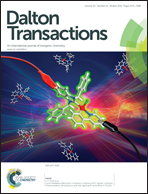[Cu(N^N)(P^P)]+ complexes with 2,2′:6′,2′′-terpyridine ligands as the N^N domain†
Abstract
The first examples of [Cu(N^N)(POP)]+ complexes (POP = bis(2-(diphenylphosphino)phenyl)ether) in which the N^N domain is a 2,2′:6′,2′′-terpyridine (tpy) ligand have been prepared and characterized; N^N = tpy, 5,5′′-dimethyl-2,2′:6′,2′′-terpyridine (1), 4′-(4-tolyl)-2,2′:6′,2′′-terpyridine (2), 4′-(4-npropoxyphenyl)-2,2′:6′,2′′-terpyridine (3) and 4′-(4-nbutoxyphenyl)-2,2′:6′,2′′-terpyridine (4). In solution, the tpy domain in each [Cu(N^N)(POP)][PF6] complex is C2-symmetric, consistent with either tridentate coordination or a low energy dynamic process involving bidentate ligands; for [Cu(2)(POP)][PF6] and [Cu(4)(POP)][PF6], the 1H NMR spectra showed negligible change between 295 and 210 K. The single crystal structures of [Cu(tpy)(POP)][PF6] and [Cu(4)(POP)][PF6] are presented. The asymmetric unit of [Cu(tpy)(POP)][PF6] contains two independent cations; in one the tpy ligand is tridentate and in the other, it is bidentate with the non-coordinated pyridine ring facing the Cu atom (Cu⋯N = 3.146(1) Å). In contrast, the solid-state structure of [Cu(4)(POP)][PF6] features a [Cu(4)(POP)]+ cation containing a bidentate tpy-domain with the non-coordinated pyridine ring oriented with the N-atom facing away from the Cu atom; this conformation may be associated with inter-cation N⋯HC non-classical hydrogen bonds. The photophysical properties of [Cu(N^N)(POP)][PF6] with N^N = tpy or 1–4 are described. In the solid state at room temperature, the compounds are poorly emissive. In solution, the emission behaviour is consistent with ligand dissociation. This is supported by 1H and 31P NMR spectroscopic data which show POP and [Cu(POP)2]+ in solutions of aged samples; mass spectrometric data are consistent with the formation of [Cu(N^N)2]2+ in these samples.
![Graphical abstract: [Cu(N^N)(P^P)]+ complexes with 2,2′:6′,2′′-terpyridine ligands as the N^N domain](/en/Image/Get?imageInfo.ImageType=GA&imageInfo.ImageIdentifier.ManuscriptID=C5DT00517E&imageInfo.ImageIdentifier.Year=2015)

 Please wait while we load your content...
Please wait while we load your content...